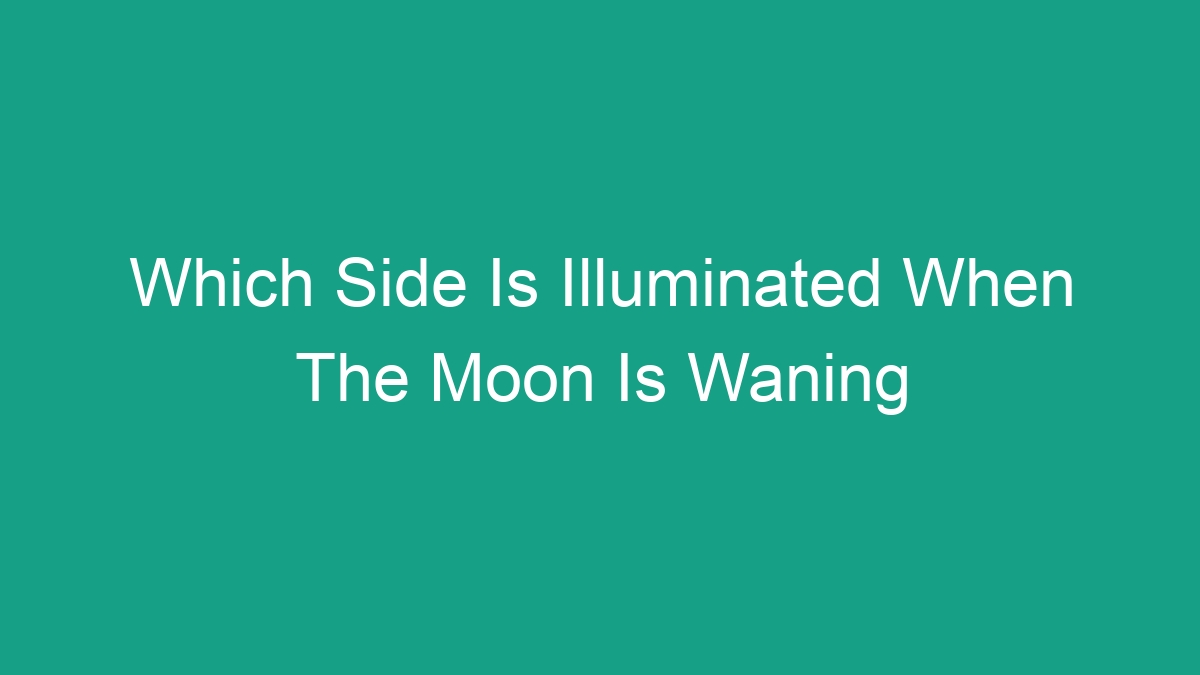
Have you ever wondered which side of the moon is illuminated when it’s waning? The moon’s phases have fascinated people for centuries, and understanding the different stages of the moon can provide insight into its orbit and the lunar cycle. In this article, we’ll take a closer look at the waning moon and explore which side is illuminated during this phase.
Understanding the Waning Moon
Before we dive into which side of the moon is illuminated during the waning phase, let’s first understand what the waning moon actually is. The waning phase occurs after the full moon and before the new moon. During this phase, the amount of illuminated moon visible from Earth gradually decreases, leading to a thin crescent and eventually no visible moon at all.
Different cultures and traditions have associated various attributes and meanings with the waning moon, and it is often linked to introspection, release, and letting go. Understanding the waning moon’s characteristics can provide a deeper appreciation for its significance in astronomy and astrology.
Which Side Is Illuminated?
When the moon is waning, the illuminated portion is on the left side as viewed from the Northern Hemisphere, and on the right side as viewed from the Southern Hemisphere. This is the opposite of the waxing moon, where the illuminated portion is on the right side in the Northern Hemisphere and on the left side in the Southern Hemisphere.
It is important to note that the orientation of the moon’s phases is reversed when transitioning between the Northern and Southern Hemispheres due to the viewer’s perspective. Understanding this phenomenon can help to clarify any confusion about which side of the moon is illuminated during the waning phase.
Factors Affecting the Illumination of the Moon
While the waning phase corresponds to a decrease in the illuminated portion of the moon, various factors can influence the visibility and brightness of the waning moon. These factors include atmospheric conditions, geographical location, and the moon’s position in its orbit.
Atmospheric Conditions: Cloud cover, pollution, and other atmospheric factors can affect the visibility and clarity of the waning moon. Clear skies provide the best conditions for observing the moon’s phases.
Geographical Location: The moon’s position in the sky can vary depending on the observer’s geographical location. This can affect the angle at which the waning moon is viewed and its visibility.
Orbital Position: The moon’s position in its orbit around the Earth can influence the angle at which it is illuminated during the waning phase. The moon’s orbit is not perfectly circular, so its distance from Earth can also impact its appearance.
Observing the Waning Moon
Observing the waning moon can be a rewarding experience for astronomy enthusiasts and casual sky gazers alike. Whether using a telescope, binoculars, or simply gazing at the night sky, there are several ways to appreciate the waning moon and its changing appearance throughout the lunar cycle.
During the waning phase, the moon appears to shift from a full circle to a thin crescent, and eventually to no visible moon at all before the new moon phase. This gradual transformation provides an opportunity to witness the dynamic nature of the moon’s phases and its relationship with Earth’s orbit.
Effect of the Waning Moon
Throughout history, the waning moon has been associated with various cultural and spiritual beliefs. In astrology and folklore, the waning moon is often linked to release, reflection, and the shedding of negativity. Some traditions also connect the waning moon with renewal and the opportunity to let go of burdens or challenges.
While these associations are not scientifically proven, the cultural significance of the waning moon highlights its enduring impact on human imagination and creativity. The waning moon’s influence on art, literature, and spiritual practices demonstrates its enduring appeal across different societies and traditions.
Conclusion
In conclusion, the waning moon is a significant phase in the lunar cycle, and understanding which side is illuminated during this phase can provide valuable insights into astronomy and celestial mechanics. Whether viewed from the Northern or Southern Hemisphere, the waning moon demonstrates the dynamic interplay between the moon’s phases and Earth’s orbit, offering a glimpse into the wonders of the cosmos.
Observing the waning moon and appreciating its changing appearance can deepen our connection to the natural world and inspire awe and curiosity about the mysteries of the universe. Whether for scientific study or personal reflection, the waning moon continues to captivate and inspire people around the world.
FAQs
Q: Does the waning moon look the same from all parts of the world?
A: No, the appearance of the waning moon can vary depending on the observer’s geographical location. The orientation of the illuminated portion is reversed between the Northern and Southern Hemispheres.
Q: Why is the waning moon associated with release and letting go?
A: The waning moon’s decreasing illumination has been symbolically linked to the idea of shedding negativity and releasing burdens. This association is prevalent in various cultural and spiritual traditions.
Q: Can the waning moon be observed during the day?
A: Yes, the waning moon can often be observed during the day, especially as it transitions from a full moon to a thin crescent. However, its visibility may be affected by daylight and atmospheric conditions.



